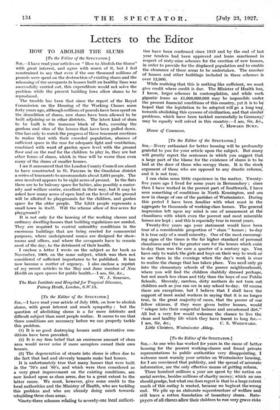Letters to the Editor
110W TO ABOLISH THE SLUMS
[To the Editor of the SPECTATOR.] SIR,—I have read your articles on "How to Abolish the Slums" with great interest, and agree with much of it, but I feel constrained to say that even if the one thousand millions of pounds were spent on the destruction of existing slums and the rehousing of the occupants in houses built on healthy lines was successfully carried out, this expenditure would not solve the problem while the present building laws allow slums to be reproduced.
The trouble has been that since the report of the Royal Commission on the Housing of the Working Classes some forty years ago, although millions of pounds have been spent on the demolition of slums, new slums have been allowed to be built adjoining or in other districts. The latest kind of slum to be built is the immense block of flats, covering the gardens and sites of the houses that have been pulled down. One has only to watch the progress of these tenement erections to realize that with their crowded population, absence of sufficient space in the rear for adequate light and ventilation, combined with want of garden space level with the ground floor and on the roof for the children to play in, they are but other forms of slums, which in time will be worse than even many of the slums of smaller houses.
I see it announced that the London County Council are about to have constructed in St. Pancras in the Ossulston district a series of tenements to accommodate about 3,054 people. The area involved appears to be eight acres of ground. In the flats there are to be balcony space for babies, also possibly a mater- nity and welfare centre, excellent in their way, but it may be asked how many acres of open land on the level of the ground will be allotted to playgrounds for the children, and garden space for the older people. The 3,054 people represents a small town in itself. Will the scheme allow of five acres for playground ?
It is not only for the housing of the working classes and ordinary dwelling-houses that building regulations are needed. They are required to control unhealthy conditions in the enormous buildings that are being erected for commercial purposes, where underground rooms are designed for show- rooms and offices, and where the occupants have to remain most of the day, to the detriment of their health.
I enclose a letter I wrote on the subject as far back as
November, 1909, on the same subject, which was then not considered of sufficient importance to be published. It has now become a matter of urgency. I also enclose a reprint of my recent articles in the May and June number of New Health on open spaces for public health.—I am, Sir, &c., W. J. SIMPSON.
The Ross Institute and Hospital for Tropical Diseases, Putney Heath, London, S.W.15.






















































 Previous page
Previous page